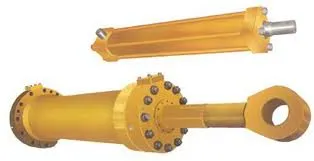Oct . 12, 2024 05:30 Back to list
Hydraulic Hose and Cylinder Solutions for Efficient Fluid Power Systems
Understanding Hydraulic Hose & Cylinder Products
Hydraulic systems are integral to modern machinery and equipment across various industries, including construction, manufacturing, agriculture, and automotive. At the heart of these systems are hydraulic hoses and cylinders, pivotal components that enable the transfer of power, control movement, and ensure the efficient operation of heavy machinery. This article will explore the significance, types, and applications of hydraulic hoses and cylinders, along with the factors to consider when selecting these components.
Hydraulic Hoses The Lifeline of Hydraulic Systems
Hydraulic hoses are flexible tubes specifically designed to convey hydraulic fluid between different parts of a hydraulic system. Their primary role is to transmit high-pressure fluid from one component to another, ensuring the hydraulic system operates smoothly. The construction of hydraulic hoses typically involves multiple layers, including an inner tube, a reinforcing layer, and an outer cover. Each layer serves a distinct purpose, contributing to the hose's strength, durability, and flexibility.
Types of Hydraulic Hoses
1. Standard Hydraulic Hoses These hoses are commonly used in various applications and typically consist of a synthetic rubber inner tube. They can handle moderate to high pressure.
2. High-Pressure Hoses As the name suggests, these hoses are designed to withstand extremely high pressures, making them suitable for heavy-duty applications.
3. Reinforced Hoses These hoses come with added layers of reinforcement, such as steel wire braiding. This makes them ideal for applications where durability and resistance to abrasion are critical.
4. Thermoplastic Hoses Made from thermoplastic materials, these hoses are lightweight and flexible, which makes them suitable for applications where space is limited.
When selecting a hydraulic hose, it is essential to consider factors such as pressure rating, temperature range, compatibility with hydraulic fluids, and environmental conditions to ensure optimal performance and longevity.
Hydraulic Cylinders The Power Actors
Hydraulic cylinders, also known as hydraulic actuators, convert hydraulic energy into mechanical energy. They create linear motion and force by utilizing hydraulic fluid pressure to push a piston within a cylinder. This transformative ability makes hydraulic cylinders invaluable in various applications, from lifting and pushing to clamping and turning.
Key Components of Hydraulic Cylinders
hydraulic hose & cylinder products

1. Cylinder Barrel The main body of the hydraulic cylinder, where the piston moves.
2. Piston The moving component inside the cylinder that is driven by hydraulic pressure.
3. Rod The extended arm of the piston that transmits the motion to other mechanical parts.
4. End Caps These seal the ends of the cylinder and house the ports for hydraulic fluid entry and exit.
Types of Hydraulic Cylinders
1. Single-Acting Cylinders These cylinders have only one port for fluid entry, allowing movement in one direction using hydraulic pressure. They typically return to their original position through a spring or gravity.
2. Double-Acting Cylinders With ports on both sides, double-acting cylinders can extend and retract under hydraulic pressure, providing greater versatility and control.
3. Telescopic Cylinders These cylinders consist of multiple nested cylinders, allowing for extended strokes in compact spaces. They are often employed in applications like dump trucks and cranes.
Applications and Industries
Hydraulic hoses and cylinders find applications in a multitude of industries. In construction, they are used in excavators, bulldozers, and cranes, which require reliable hydraulic systems for lifting heavy loads. In manufacturing, hydraulic presses and automation equipment utilize these components for efficiency and precision. Agricultural machinery, such as tractors and harvesters, relies on hydraulic systems to enhance productivity.
Conclusion
In summary, hydraulic hoses and cylinders are indispensable elements of hydraulic systems that provide power, mobility, and efficiency across various industries and applications. Understanding the types, functions, and selection criteria for these components is crucial for engineers, designers, and operators to ensure the reliable operation of their hydraulic systems. As technology advances, so will the design and capabilities of hydraulic hoses and cylinders, continually enhancing their roles in industrial applications. Investing in high-quality hydraulic components not only maximizes performance but also minimizes downtime and maintenance costs, making them a wise choice for any industry reliant on hydraulic power.
-
1.5 Ton Lifting Cylinder 70/82-40-290-535 | Hebei Shenghan
NewsAug.13,2025
-
1.5 Ton Lifting Cylinder 70/82-40-290-535-Hebei Shenghan|Precision Hydraulic Solutions
NewsAug.13,2025
-
1.5 Ton Lifting Cylinder 70/82-40-290-535-Hebei Shenghan Hydraulic Machinery Co., Ltd.|Precision Manufacturing&Customization
NewsAug.13,2025
-
Heavy-Duty Snowplow Power Units for Optimal Performance
NewsAug.13,2025
-
1.5 Ton Lifting Cylinder-Hebei Shenghan|Precision Engineering&Durable Components
NewsAug.13,2025
-
1.5 Ton Lifting Cylinder 70/82-40-290-535-Hebei Shenghan|Hydraulic Solutions, Heavy-Duty Lifting
NewsAug.12,2025
